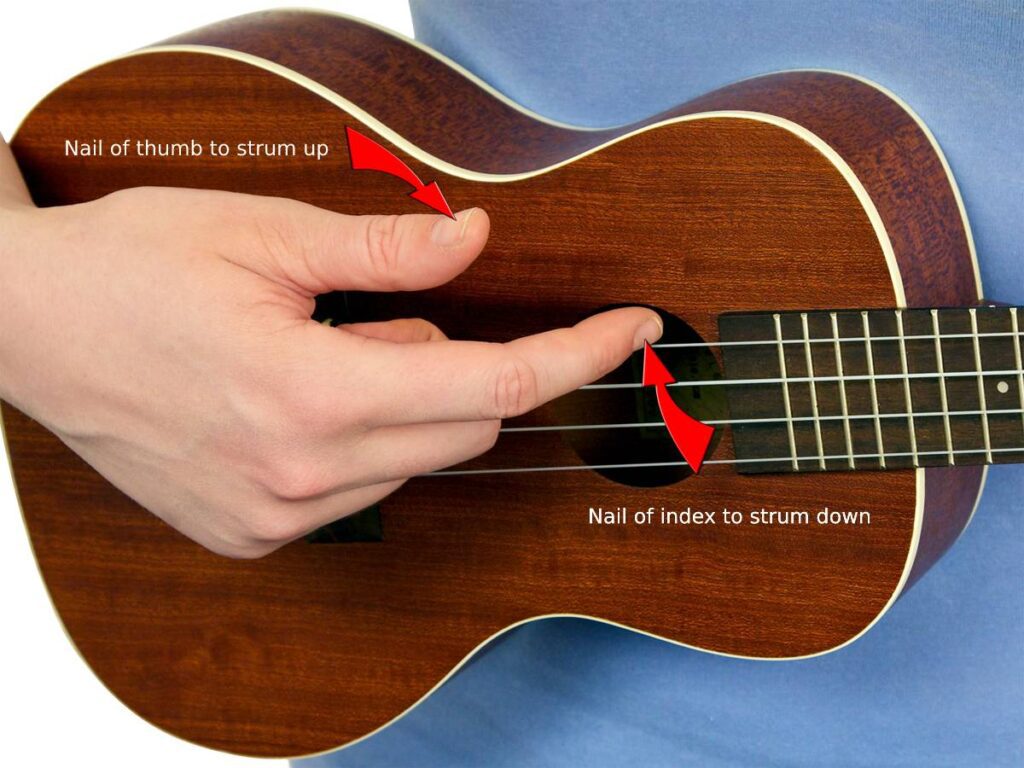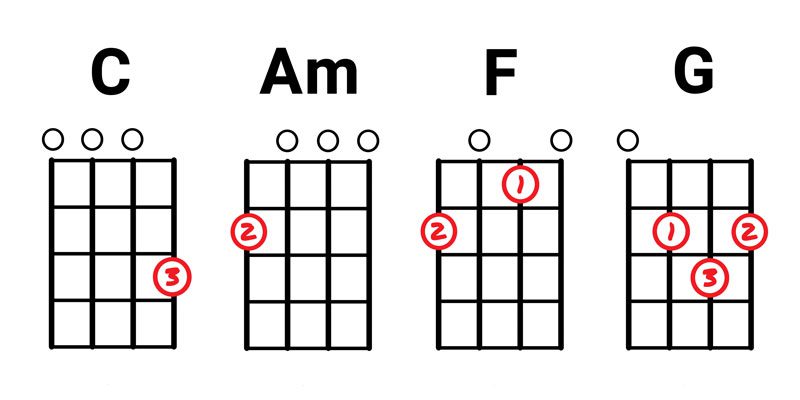The Ultimate Step by Step Guide for Beginners

In this article, I am going to teach you how to play ukulele one step at a time. Firstly, I will teach you the 4 basic ukulele chords, which are C – F – Am and G. Secondly, you’ll learn how to develop the universal strumming pattern: (down, down, up, up, down, up).
Lastly, I will provide you with a list of detailed PDF’s of 10 popular songs that use the 4 basic ukulele chords. They are, The Hokey Pokey, Three Little Birds, Mr. Tambourine Man, Cups, Rip Tide, Leaving on a Jet Plane, Let it Be, Country Roads: Chorus + Verse, I’m Yours, Stand By Me.
After you’ve gone through the exercises in this article, you will have all the necessary skills to play through the previously mentioned song list and thousands of other songs.
First, let’s go through a few FAQ’s.
FAQ
How Hard is it to Learn Ukulele?
The ukulele is one of easiest instruments to learn and has a very fast learning curve (compared to the guitar, violin and most other string instruments). There are a few reasons for this:
– The small size of the ukulele makes it easy for anyone to play, no matter how small their hands are.
– The ukulele’s nylon strings are made out of a soft plastic, which is gentle on the fingers (unlike the steel strings often found on acoustic guitars).
– You can learn the 4 basic chords (C, F, Am, G) on the ukulele, in a matter of weeks (the same chords on the guitar takes months or even years to learn).
– After learning these 4 basic chords, you can play and sing along to hundreds of popular songs.
– The ukulele is best played using the fingers, which is easier than using a pick or a bow (for violin).
To sum up, how hard is it to learn to play ukulele? The answer is, pretty easy if you want to learn the basics. However, if you want to play like Jake Shimabukuro, then I would say it’s pretty hard.
How long does it take to learn ukulele?
How long does it take to learn ukulele? The answer is, to learn the basics, which includes switching between C – F – Am – G, and playing a simple strumming pattern in the right hand, it will take between 1- 4 months.
If you’ve played another instrument before the ukulele, (especially the guitar), then it will be much faster.
Best Beginner Ukulele Book
This is one of the best beginner ukulele books. The book is designed for kids, but is suitable for adults. As a ukulele teacher myself, I’ve gone through a variety of ukulele method books and I’ve found this one to one of the best for both adults and kids. Moreover, the song selection is great and includes popular songs such as Yellow Submarine, I’m Yours, Mr. Tambourine Man, 3 Little Birds, and much more.

Buy Online in the US -> 12.99 USD
Buy Online in Canada -> 16.39 CAD
How to Hold the Ukulele
The best way to hold the ukulele is to cradle the neck in your left hand (in the crease of your thumb and index fingers). Holding the ukulele this way allows you to play without a strap.
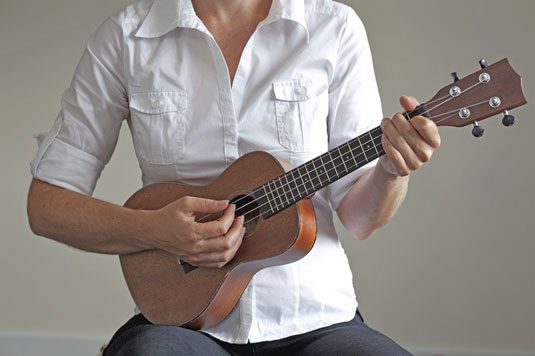
- Press the body of the ukulele flat against your stomach.
- Keep your wrist straight and your hand should be in line with your elbow.
- Your thumb should come out over the top of the neck
- The forearm of your right hand should help support the ukulele by gently pressing against it.

Learn your first ukulele chord: C
The C chord is the first chord that you should learn on the ukulele. To do this, place your 3rd finger (ring finger) on the 3rd fret of the 1st string.
Next, with your right hand, simply strum downward for now (more on strumming patterns later). You can use your thumb or the nail of your first finger. Count 1-2-3-4 over and over as you strum.
Once you can do this comfortably, you’re ready to play your first ukulele song.
Are You Strumming is a great song to play over this chord. (It’s set to the melody of Brother John)
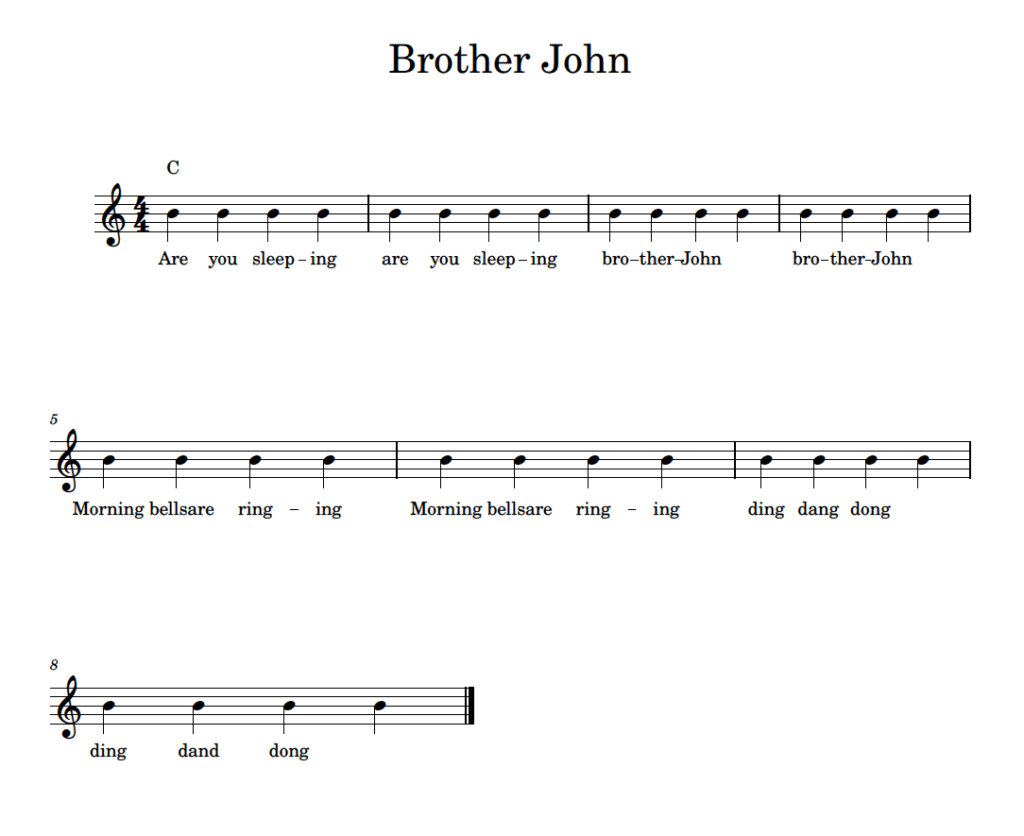
Your 2nd ukulele chord: F
The F chord is a little harder and requires 2 fingers: the index and middle finger.
Here are a few tips to play the F chord:
- Keep your fingers rounded to avoid muting the other strings.
- Play on the tips of your fingers and not on the finger print.
- Position the F chord, then play one string at a time before strumming. (This will allow you to test if all the notes are coming out well.)
Switching chords: F – C
One of the main challenges of playing the ukulele is to fluidly switch from one chord to another. The following exercise is helpful for achieving this. Start by playing the F chord for 4 counts. Then pause for 4 counts. Finally, to the C for another 4 counts.
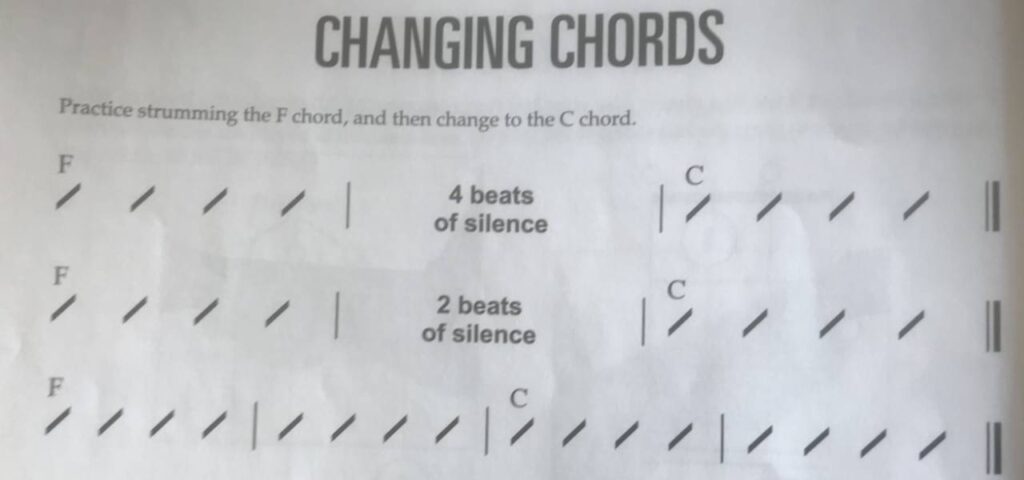
Each line reduces the amount of space between chords, until the last line where you have to switch chords without losing a beat.
Need some help? Signup for an online class, and I can help you through your issue.
Play a 2 chord song: Yellow Submarine
After developing the ability to switch between F and C, we are now ready to play Yellow Submarine by the Beatles. We’ll focus on the chorus part of this song.
-> Download the Yellow Submarine PDF
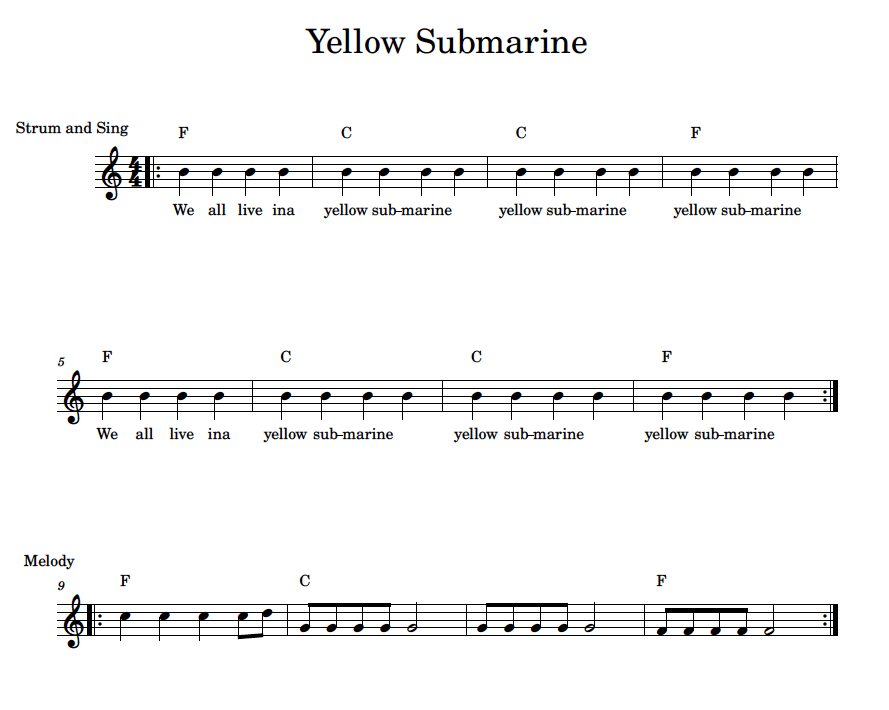
The first step to learning any song is to break it down into parts. Aim to learn the chords by themselves without singing the lyrics. Play only down strums, 4 per measure, and try to eliminate any delays when you switch from one chord to another.
*If you’re having trouble with delays, review the changing chords exercise above.
Once you can play the chords comfortably on your own, try to sing the lyrics with the chords. It can be tricky to sing exactly the right notes. A little trick to getting the right notes in your ear before singing, is to learn the melody (individual notes) of the song on the ukulele and matching your singing to the notes that you are playing.
*See the end of the yellow submarine video to learn the melody.
Your 3rd chord: Am
This third chord is pretty easy and only uses only the middle finger.
- Practise counting 1,2,3,4 while playing this chord.
- Make sure to play on the point of your finger and not the print, as to avoid muting the string below your finger.
- Keep the finger round.
Your 4th chord: G
We’ve come to our 4th and final chord of this article, the G chord. This is the hardest chord to play because it utilises 3 fingers at once. Don’t get discouraged if you don’t get this chord right away. It can take a little while to get comfortable with it.
- If you are having trouble getting all the notes to sound clean, work on placing one finger at a time, and testing the sound of each string, before placing the other fingers.
- Make sure each finger is curved and that you are playing on the tip of your fingers.
- Pay attention to how close your fingers are to the metal frets. You should be as close as possible to the fret, without touching it.
- Once you can get all the notes to resonate clearly, practise playing down strums while counting 1,2,3,4.
Now work on switching from the C to G chords.
*When switching to the G chord, try placing your ring finger finger first as it’s the “slowest finger.” Once the ring finger is in place, place the “quicker” index and middle fingers.
Strumming patterns
Up until now, in terms of strumming, we’ve only focused on playing down-strums with either your thumb or the nail of your index finger. In order to play interesting strumming patterns to give a little more life to your ukulele playing, you’ll need to get comfortable playing up-strums as well as learning a few new rhythms.
For the following exercises, use the chord of your choice. Beyond working on your right hand strumming, you can think of these exercises as a way of practising your chords outside of a song.
-> Download the ukulele strumming pdf
- The first strumming pattern is the easiest and sounds great for playing your first few songs. We’ll simply play down-strums for this while counting 1, 2, 3, 4. Use the nail of your index finger for this.

- Secondly, we’ll play eighth notes. Eighth notes are played twice as fast as quarter notes and counted: 1 + 2 + 3 + 4 +. This strum pattern is played with a down and up hand motion. The down strums are played on the numbers, and the up-strums are played on the +, using the nail of your thumb.
*Once this starts to feel comfortable, practise switching from strumming pattern #1 to #2 without stopping.
** This pattern works great for “I’m Yours” by Jason Mraz and “Cups” by Anna Kendrick. See the PDF of these songs below.

- Thirdly, we’ll work on playing only the upbeats. We’ll continue to count 1 + 2 + 3 + 4 +, however we’ll avoid touching the strings on the down strums (notice the dotted arrow that illustrate this). Strum the strings on the way up with the nail of your thumb on the +.

- The fourth rhythm is similar to Israel “IZ” Kamakawiwoʻole Somewhere over the Rainbow. It uses both down and up strums. Continue counting 1 + 2 + 3 + 4 +, however on the + of beat 1 and 3, don’t hit the strings on the up strum.

- Finally, I like to call this next pattern the universal strumming pattern, because it sounds great on many songs including Country Roads, Let It Be and many more. This pattern uses a combination of all the rhythms that we previously worked on.

*If you’re having trouble playing this pattern, work on beats 1 and 2 then stop. After, work on beats 3 and 4 and stop. Once you’ve done this a few times, try to bring it all together.
All the previous patterns can be used on different songs. Generally, the universal strumming pattern sounds best on most songs, however if you are having trouble singing the lyrics of a particular song using the universal strumming pattern, try working with an easier pattern (like #1 or #2).
Eventually, you’ll be able to play the song with the universal strumming pattern.
“Swinging” the Universal Strumming Pattern (more advanced)
Understanding Triplets
Many popular songs use a “swing feel”. The term “swing” comes from Jazz and refers to the eighth notes being swung. This can be a little challenging for people who haven’t learned to read music. Don’t give up on this concept, because I have a few tricks to make it more intuitive.
“Swing” means that the underlying rhythm of a song is in triplets.
For ex. Our universal strumming pattern looks like this.
Straight (eighth note subdivision)

Swing (triplet subdivision)

One common way to understand how to play the swing feel is to count the triplet subdivision (1-tri-plet, 2-tri-plet, 3 tri-plet, 4 tri-plet) while clapping the rhythm. Once you’re comfortable with clapping, you can try the swing feel on the ukulele. Count the triplets at first, then eventually attempt it without counting.
Notice the bouncy, swinging feel of it.
Singing a Phrase
Another, more intuitive way to add a swing feel, is to sing a phrase on top of the universal strumming pattern while you play.
Eat good cake, I like to
Eat good cake, I like to
This swing version of the universal strumming pattern sounds great on country songs like Country Roads by John Denver.
To compare, I’m Yours by Jason Mraz uses the straight pattern version of the universal strumming pattern.
Learn these popular 4 chord songs and many more
-> Easy Ukulele Songs for Beginners PDF
Conclusion
Hopefully this article helped you learn the basics of the ukulele and helped get you playing your first song as quickly as possible.
The great thing about the ukulele is that you can learn it faster than most instruments. Once you have the basic chords down and the universal strumming pattern, you can use it to accompany yourself while singing so many classic songs. Most other instruments have a much longer learning curve before being able to play songs you like.
The material in this post is what I use to teach my private ukulele students. If you’d like any help along the way, consider signing up for a online ukulele lesson with me. It might just take you one lesson to get through whatever block you’re experiencing, or lessons could be go on weekly.
-> Sign up for an online ukulele lesson with me.
About Musiprof
Musiprof is a canadian music organization that connects qualified music teachers to students. Musiprof also believes that playing should be enjoyed by everyone and not just professional musicians. After all, playing music helps everyone live happier and healthier lives.
- To find a ukulele teacher in Montreal, visit: Ukulele lessons Montreal
- If you’e interested in finding a teacher in Vancouver, visit Ukulele lessons Vancouver
- Looking for a teacher in Toronto? Ukulele lessons Toronto

